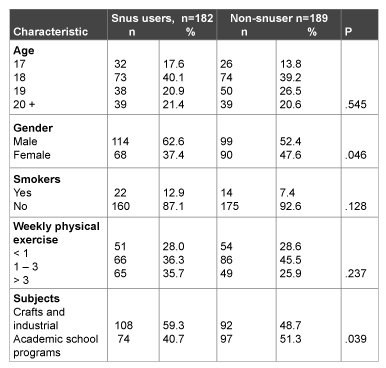
Table 1: Characteristics of the 371 respondents in relation to snus use

Katrine Gullhav Hansen# Sandra Marie Jakobsen# Lisa Søreide Johansen# Werner Johansen# Elin Hadler-Olsen*
Department of Medical Biology, Faculty of Health Sciences, University of Tromsø, Tromsø, Norway # Equal contribution*Corresponding author: Elin Hadler-Olsen, Department of Medical Biology, Faculty of Health Sciences, University of Tromsø, Tromsø, Norway, E-mail: elin.hadler-olsen@uit.no
Background
Use of Scandinavian moist snuff, snus, is steadily increasing in Norway, especially among young adults. Although snus is far less harmful than cigarettes,the degree of harm reduction is controversial. Thus, the trend of increased snus use should be turned. To do that efficiently,information about snus habits of young adults as well as their attitude and knowledge about snus is needed. Therefore, the aim of the present study was to increase the knowledge of when and why adolescents start using snus, if they feel addicted to snus and their motivation to stop using snus. We also wanted to assess how adolescents perceive health risks associated with snus, and where they receive information about snus.
Methods
A questionnary was distributed to all senior high school graduates in Tromsø County, the largest city in Northern Norway. Age, gender, school subjects, sporting activities,snus and smoking habits were recorded. There were also questions to assess why the students started using snus, feeling of addiction and desire of quitting, as well as statements about snus associated health risks which they were to evaluate as true or false.
Results and conclusions
Of the 773 students asked to participate, 371 (48 %) responded. Of those, 49 % were using snus either daily (38 %) or now and then (11%). Most of the snus users felt addicted to the habit and used snus throughout the day. Snus habits settled at an early age, thus preventive efforts should start early. Curiosity and friends that were using snus were common reasons to start using snus, whereas pleasant taste and relaxation were the most common reasons for keeping the habit. The majority of the snus users did not want to quit the habit.Preventive efforts should take this into consideration, perhaps by working on attitudes and peer pressure. The ban on snus use at schools did not seem to be efficient; legislations restricting the number of taste additives allowed in snus could be an alternative approach to reduce the attractiveness of snus.
Scandinavian moist snuff; Habit; Information; Addiction; Prevention
During the past 20 years the number of Norwegian adults (16-74 years of age) using smokeless tobacco in the form of Scandinavian moist snuff called snus has steadily increased. In 1992, 2% of the adult population used snus daily, compared to 9 % in 2012, according to data from Statistics Norway – the official statistics about the Norwegian society (SSB) [1].
Although there seems to be a general agreement among tobacco researchers that use of the Scandinavian snus is far less harmful than cigarettes, the extent of harm reduction is controversial. Snus contains 20 chemicals classified as carcinogenic [2,3] of which tobacco-specific N-nitrosamines (TSNAs) are some of the most potent. By refining the processing methods of snus, the content of TSNAs has been reduced [4], but they are not removed [2]. The nicotine content, which causes the physical addiction to tobacco products, varies between different brands of snus. However, a dose of snus gives about the same level of venous nicotine as a cigarette, but the absorption rate is slightly slower [2]. Use of snus has been associated with various health hazards including increased risk of pancreatic, oral, pharyngeal, oesophageal and stomach cancer [5-11], as well as cardio-vascular diseases [12,13], type II diabetes [14] and periodontitis [15,16]. The health risks of snus have however been questioned in several recent reviews [2,17-22], and from the epidemiological data available today, there seems to be vague associations between use of snus and development of these diseases. Studies have found that use of snus during pregnancy may cause increased risk of lower birth weight, stillbirth, neonatal apnoea, preterm delivery and preeclampsia [23-25]. Although a recent sibling study questioned the effect of snus use on birth-weight [26], it still raises a concern about the strong increase in snus use among young women.
As the available data today indicate that the health risks associated with snus are much lower than with cigarette smoking, snus has been launched as a nicotine substitute for cigarettes [27,28], and about 16% of previous smokers in Norway reported that they started to use snus to help quit smoking [1]. Nevertheless, the largest increase in use of snus in Norway is seen in young adults who have never been smokers [1]. According to data from SSB, 19% of Norwegian adults between 16 and 24 years use snus daily, 25% of men and 14% of women [1]. In addition, about 10% of both genders in this age-group use it on a more irregular basis.
The reasons for the dramatic increase in snus use among young Norwegian adults are not known. The strict regulations in where smoking is permitted may however have caused a shift in tobacco consumption from smoking to snus; as snus is allowed to consume most places it may feel more convenient. During the last decades, there has also been a strong public focus on the health risks related to cigarette smoking. The Norwegian health governments have regular “quit-smoking” campaigns, and there is a large, eye-catching cancer risk warning on cigarette packages sold in Norway. In contrast, due to an EU-directive from 2001, the cancer risk warning on snus boxes was in 2003 replaced by a more unspecific warning that snus may be a health risk, which seems less intimidating than the previous cancer warning. Therefore, for young adults who want to experiment with tobacco products, snus may appear as a more appealing alternative than cigarettes. There are also studies indicating that smoking has become untrendy the last decades, associated with low socio economic status and an unhealthy life style [29]. The attitude towards snus among young Norwegians is not much studied.
For adolescents who have never been smokers, snus represents a new, addictive habit. There is also a concern that use of snus may be a gateway into smoking, especially for those with an early age snus debut [30,31]. Therefore, the dramatic increase in snus use among young adults is worrying and should be reversed. To be able to do that effectively, it is important to have information about the snus habits of young adults. Thus, the aim of the present study was to increase the knowledge of when and why adolescents start using snus, why they keep the habit, if they feel addicted to snus, if they want to quit the habit and what might motivate them to stop using snus. We also wanted to assess how adolescents perceive health risks associated with snus, and where they receive information about snus.
A questionnary was design in the QuestBack platform (QuestBack AS, Oslo, Norway), which has an integral system to secure the anonymity of the respondents. Age, gender, school subjects, sporting activities as well as snus and smoking habits were recorded. There were also questions to assess why the students started using snus, if they felt addicted to snus and if they wanted to quit the habit. Those who did not use snus were asked why they had chosen not to use snus, if they believed that they would start using snus later or if they felt a pressure towards starting. Finally, the questionnary contained a number of statements about health risks associated with use of snus, which they were to evaluate as true or false. The six senior high schools in Tromsø County, the largest city in Northern Norway, received written information about the project, and were asked to participate. All schools accepted, and altogether, 773 senior students were asked to answer the questionnary electronically. The questionnary was distributed to the students by e-mail. In some of the schools the students were allowed to answer the questionnary during a lecture, whereas students in other schools did not have this option. The study was conducted in May and June 2013. One of the high schools in the study had separate classes for persons to be re-educated, and in these classes the students were somewhat older than in the regular high school classes. This group was included in the study and denoted 20+.
Results from the questionnary were imported into IBM SPSS (Version 21 for Mac IBM, Armonk, NY), and descriptive and comparative analyses (Chi-square-tests) were performed. P-values <0.05 were accepted as statistically significant.
Of the 773 students who were asked to answer the questionnary, 371 (48%) responded. The characteristics of the respondents with correlation to snus habits are summarized in Table 1.
Altogether 182 respondents (49 %) reported using snus, 38 % daily and 11 % now and then. These students were asked questions to more precisely characterize their snus habits, the results are summarized in Table 2. Of those reporting that they used snus now and then, the majority used it during weekends and at parties, whereas a few stated that they used snus when they did not have cigarettes available or when they were together with friends who were using snus. The now and then users all consumed less than 2 boxes of snus per week. Most of the daily snus users (93 %), reported that they used snus throughout the day. Seventy percent of them consumed 2-4 snus boxes per week, whereas 19 % consumed 5 or more boxes.The daily and irregular snus users otherwise responded similarly to most questions related to snus habits, and are therefore grouped in most analyses (Table 2). The majority of the snus users felt addicted to the habit, and the feeling of addiction was strongly correlated to number of snus boxes consumed per week (p<0,001). Almost one third of the snus users wanted to quit the habit, but a significantly higher portion of those who felt addicted to snus wanted to quit compared to those who did not feel addicted (42 % vs. 22 %, p=0.009).

Table 1: Characteristics of the 371 respondents in relation to snus use
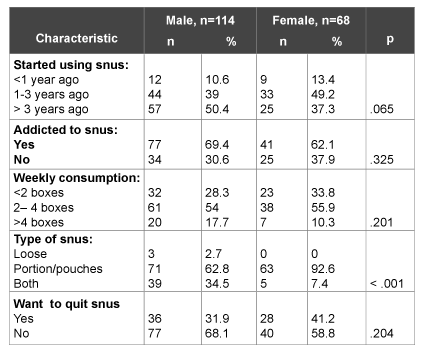
Table 2: Description of snus habits of the 182 snus users
Figure 1 illustrates why the respondents had started using snus. In the group “other” reasons, about 25 % specified that they started because snus was cool or popular, 10 % started to cope with stress or psychological problems and 10 % because snus tastes good. Figure 2 illustrates the reasons given for keep using snus. In the group “other”, the most commonly reported reason was nicotine dependence. There was no statistically significant gender difference in reported reasons for using snus. Prohibition, higher prizes or information about harmful side effects were the most commonly stated changes that would make the students want to stop using snus.
In the group of snus-abstinent students, the most commonly reported reasons for not using snus was that snus doesn’t taste good, isn’t cool or doesn’t look good, as well as worries about harmful effects of snus. urthermore, about 20% stated that they couldn’t afford the costs of using snus. Eight percent of the students reported that they believed that they might start using snus later, whereas 10% reported that they felt a pressure towards starting.
A significantly higher proportion of snus users reported that they had received information about snus than those not using snus (71% vs. 59%, p=0.012). Figure 3 summarize where the students had received information about snus. More snus users got information at home, from dental care providers and from the internet than those who did not use snus (P ≤ 0.001 for each of the information sources). Furthermore, a significantly higher proportion of the snus users wanted more information about snus compared to those who were not using snus (34% vs. 16%, p>0.001). Snus users and those not using snus answered similarly on most questions related to harmful effects of snus (Figure 4).
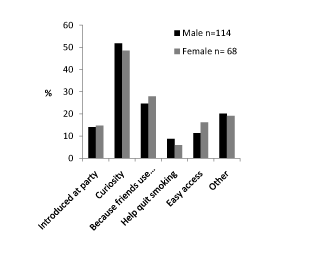
Figure 1: Reasons to start using snus The 182 students who were using snus were asked why they had started, and the answers are graphically illustrated in Figure 1. The respondents could choose multiple answers.
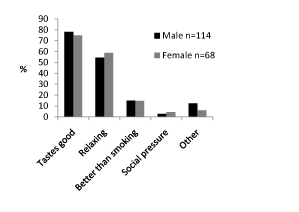
Figure 2: Reasons to start using snus The students were asked why they used snus, and their answers are graphically illustrated in Figure 2. The respondents could choose multiple answers.
While use of cigarettes, alcohol and narcotic drugs are decreasing among young Norwegians [32], the use of snus is steadily increasing. In the present study we found a higher percentage of daily snus users among both genders (43 % of male students and 33 % of female students) than national data from SSB (25 % of male and 14 % of female) [1]. The data from SSB are based on a nationally representative cohort regarding geographical distribution and gender, whereas our study included senior students at the high schools in Tromsø, the largest city in Northern Norway, which also recruits students from rural areas in its region. Almost half of the senior students answered the questionnary, but the response rate differed between schools. In some of the schools the students were allowed to answer the questionnary during a lecture, which gave a high response rate, whereas students in other schools did not have this option, and thus had a lower response rate. The proportion of crafts and industrial students is higher among the respondents than among the 773 students asked to participate. As these students had a significantly higher proportion of snus users than students of academic school programs (59 % vs. 41 %, p=0.039), our numbers may be overestimating the snus use in this age group. The prevalence data from this study should therefore be interpreted with care. Nevertheless, we believe that the descriptions of snus habits, knowledge and information channels about snus are relevant and can give insight that can be used to turn the trend of increasing snus use among young adults in Norway
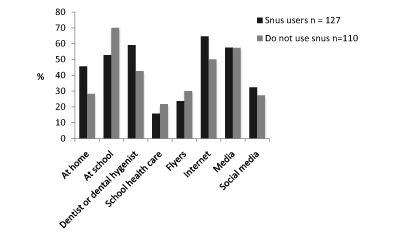
Figure 3:Sources of information about snus The students were asked where they had received information about snus, and their answers are graphically illustrated in Figure 3. The respondents could choose multiple answers.

Figure 4:Believes about health risks associated with snus The students were asked to evaluate a number of statements of health hazards associated with use of snus as true or false. Figure 4 illustrates graphically the percentage of students who evaluated the listed statements as true.
The majority of the snus using students in our study had started using snus more than three years ago while still in middle school, and most of them felt addicted to the habit. Of the students that were not using snus, the vast majority did not believe that they would ever start, indicating that the snus habits settles at an early age. This emphasise the importance of starting preventive efforts early, during primary- or the first years of middle school.
There has been a debate whether use of snus may be a gateway into smoking or if snus replaces cigarette smoking among young adults, and therefore reduces the total health risks associated with tobacco use. There are studies in support of both opinions [2,33-35], and some recent studies indicate that the debut age of snus use may be of importance [30,31]. A recent Norwegian study found that those initiating snus use before the age of 16 had an overall increased risk of starting smoking, whereas those who started after the age of 16 had a lower risk of smoking uptake than both early onset snus users and never snus users [30]. The study did not control for confounding factors, but suggests that in a harm reduction perspective, it could be advantageous to delay the onset of snus use, even if some will take up the habit at a later age. This further demonstrates the importance of early preventive efforts. In the present study we found no statistically significant difference in proportion of cigarette smokers among snus users and abstinent when daily and now- and then snus users were grouped (Table 1), but when split, there was a significantly higher proportion of smokers among those using snus now and then compared to daily snus users and abstinent (20.5% vs. 9.8% and 7.4% respectively, p=0.04). This may be smokers who use snus as nicotine substitute when and where smoking is not allowed. Thus, although we have a small and not representative population, our results do not indicate that snus protects from cigarette use. Rather, the high amount of snus users among the most physically active students (Table 1), which is a low-risk group for smoking [36-38], suggests that snus users are recruited also outside of the classical risk groups associated with cigarette smoking [39]. This is important to take into consideration when preventive efforts are designed.
To be able to efficiently prevent snus use among adolescents, it is important to know their motivation for establishing and keeping the habit. Of all the respondents, 94 % reported that it was common to use snus among their friends and class mates, and half of the snus users reported that they started using snus due to curiosity. About a quarter of them said they started using snus because their friends did, while only 2% reported that they had felt a pressure to start. This indicates that the use of snus among friends evokes a curiosity, but not necessarily a feeling of pressure towards testing it. Previous studies have shown that smoking habits of friends is a strong determinant of adolescents’ smoking habits [40], and our study supports a similar association for use of snus. This suggests that it is important to raise the awareness among adolescents on how their choices influence their friends, even if no direct pressure is forwarded.
A study from 2009 including 2400 young Norwegians found that use of snus was perceived as trendy, although unattractive [41]. The unattractive appearance of snus use was also one of the most common reasons given for being snus abstinent in our study, suggesting that the way you look when using snus is an important issue for adolescents. During the last 10 years, new snus products have been introduced on the Norwegian market where the snus is made more delicate. Most of the new snus products are in the form of small pouches (portion snus), which keep the snus stationary and discrete in contrast to the loose snus which have a tendency of seeping and may be exposed when talking and smiling. Some producers have also made pouches with coloured wrappings, and many snus boxes have a nice design, some looking almost like boxes of pastilles or chewing gum. This is probably done to make the snus more appealing to women and to bring about an association to harmless products like chewing gum. Furthermore, many snus boxes have a separate room to dispose the used snus pouches, which makes it easy to switch pouches un-noticed and without access to a waste-bin. These changes have most likely contributed to making snus less unattractive, and even trendier among young adults of both sexes, which is supported by the fact that the vast majority of snus users in our study consumed portion snus. It also demonstrates that the tobacco companies are actively developing their products to reach new groups of consumers, and succeed. Recently, the Norwegian government suggested having a uniform, more “boring” design of all snus boxes sold in Norway as an attempt to make snus less trendy. It is not known whether the suggestion will gain enough support to be followed through, but it illustrates that designer snus boxes is believed to contribute to the popularity of snus among adolescents. Based on the popularity of portion snus, prohibition of this type of snus could be more efficient than changing the design of the snus boxes. Use of portion snus is however associated with development of less severe mucosal lesions than loose snus [42], which questions the rationale of prohibiting this putatively less harmful delivery form of snus.
The majority of the snus users felt addicted to the habit, otherwise, pleasant taste and relaxation were the predominant reasons given for keeping the habit. The most commonly reported reason for not using snus was unpleasant taste (58%). This suggests that taste is an important factor determining whether to use snus or not. There is currently a discussion of whether to restrict the number of taste additives allowed in snus sold in Norway, and our results indicate that this may be an effective way of making snus less attractive, and may perhaps limit the number of new snus users. Whether it will have an effect on those already addicted, is an open question.
Almost a third of the snus users wanted to quit the habit, but the percentage was higher among those who felt addicted than those who did not feel addicted. This could be because the snus becomes more a need than a choice when addicted. A common answer to the question of what would make the students stop using snus, was that they had to be motivated, they needed to want to stop. Otherwise prohibition, higher prizes and information about harmful effects were the most common reasons to want to stop, but none of them had a high very score (<20% each). This suggests that the students find legislations of minor importance when deciding whether to continue using snus or not. This is further supported in the fact that the majority of the snus users reported that they used snus throughout the day, despite that use of snus was prohibited in the high schools in Tromsø County when the study was conducted (May/ June 2013). Since January 2014, use of snus has been banned in high schools throughout the country, but our results suggest that prohibition alone is an inefficient way of inhibiting use of snus. This could be because the teachers do not prioritize to follow up on the legislation, or the use of small snus pouches may be difficult to detect. Therefore, a discussion is warranted on how to increase the students’ endogenous motivationto stop, which, based on the above discussion, may be by changing the attractiveness of snus rather than prohibition. It should also be clarified whether teachers are motivated and able to follow up the prohibition of snus use in schools, if not, this legislation is not likely to impact the snus use of students. Furthermore, it is illegal to sell snus to persons younger than 18 years in Norway, and shops are not allowed to have tobacco products on show in their shelves. Thus, customers who are to buy snus or cigarettes need to ask for it specifically, which should make control of the customers’ age easy. However, the wide use of snus among the youngest students in our survey and the fact that most of the students had started using snus during middle school, indicates that snus is easily accessible to persons younger than 18 years. This suggests that shops do not control the age of snus buyers or older persons may be re-distributing snus to minors. A study addressing how adolescents younger than 18 years of age get hold of their snus would be interesting, and could give an indication of how the access to snus for minors can be restricted more efficiently
Interestingly, a higher proportion of snus users had received information about snus from dentists, dental hygienists and from parents compared to those who did not use snus. This indicates that information may be given once the habit has settled, and not in advance to avoid establishment of the habit. One of the reasons for this delay in information/prevention may be that parents and health care providers have not been aware of how common use of snus has become, and therefore have not considered it as something to worry about. Therefore, it is important to inform parents, health care professionals as well as teachers about the strong increase in snus use among young Norwegian. As the majority of adolescents have regular dental examinations, dentists or dental hygienists could be a valuable source of information and preventive efforts.
There was no marked difference in level of knowledge about harmful effects of snus between those who used snus and not. About 65 % of the snus users believed that snus use increased the risk of developing cancer, but as they still used snus, they may find the risks low or too far ahead in time to care about. The fact that snus has been suggested as a nicotine substitute for those who wants to quit smoking, may also signal that snus is rather safe. Nevertheless, only 45% of the students that did not use snus, and 70% of those who did, believed that snus was less harmful than cigarettes. This suggests that the information given today tend to overestimate the dangers associated with use of snus, whether this is done deliberately to scare people from using snus, or if there is a lack of knowledge among the informants is not known. As all data available today indicate that health hazards associated with snus are far less than with cigarette smoking, it is important that the population is aware of this to avoid that snus users switch to cigarettes.
There are several limitations to our study. First, as already mentioned, the response rate was only about 50 %, and the sample may not be representative of all high school students in Norway. However, our sample contained a high number of snus users, and their answers are important for better tailoring of preventive efforts. Also, the questionnary was not validated, meaning that some questions could be confusing or not optimally phrased. The answers still appeared consistent and without obvious misunderstandings.
Our study demonstrates that snus use is very common among graduate high school students in Tromsø and that the habit settles at an early age. Curiosity was an important reason to start using snus, and addiction and pleasant taste was important reasons for keeping the habit. The majority of the snus users in our study did not want to quit the habit, even if they knew about potential harmful effects of snus. Our study suggests that efforts to decrease the attractiveness of snus, rather than prohibition of snus use may help turning the dramatic increase in snus use among young Norwegians. Due to the low debut age of snus use, it is also important to start preventive efforts early, before the habit settles.
We thank Dr. Jan Are Kolset Johansen for help with statistical analyses.
Download Provisional PDF Here
Article Type: Research Article
Citation: Hansen KG, Jakobsen SM, Johansen LS, Johansen W, Hadler-Olsen E (2015) Snus Habits of Norwegian Senior High School Students. Int J Dent Oral Health 1(3): doi http://dx.doi.org/10.16966/2378- 7090.121
Copyright: © 2015 Hansen KG, et al. This is an open-access article distributed under the terms of the Creative Commons Attribution License, which permits unrestricted use, distribution, and reproduction in any medium, provided the original author and source are credited.
Publication history:
All Sci Forschen Journals are Open Access